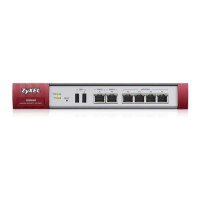137
After you configure the VPN gateway and VPN connection settings, set up the VPN settings on the
peer IPSec router and try to establish the VPN tunnel. To trigger the VPN, either try to connect to a
device on the peer IPSec router’s LAN or click Configuration > VPN > IPSec VPN > VPN
Connection and use the VPN connection screen’s Connect icon.
3.1.2 Configure Security Policies for the VPN Tunnel
You configure security policies based on zones. The new VPN connection was assigned to the
IPSec_VPN zone. By default, there are no security restrictions on the IPSec_VPN zone, so, next,
you should set up security policies that apply to the IPSec_VPN zone.
3.1.3 What Can Go Wrong
If the IPSec tunnel does not build properly, the problem is likely a configuration error at one of the
IPSec routers. Log into both IPSec routers and check the settings in each field methodically and
slowly. Make sure both the USG and remote IPSec router have the same security settings for the VPN
tunnel. It may help to display the settings for both routers side-by-side.
Here are some general suggestions.
• The system log can often help to identify a configuration problem.
• If you enable NAT traversal, the remote IPSec device must also have NAT traversal enabled.
• Both routers must use the same authentication method to establish the IKE SA.
• Both routers must use the same negotiation mode, encryption algorithm, authentication
algorithm, and DH key group.
• When using manual keys, both routers must use the same encryption key and authentication
key.
• When using pre-shared keys, both routers must use the same pre-shared key.
• The USG’s local and peer ID type and content must match the remote IPSec router’s peer and local
ID type and content, respectively.
• Both routers must use the same active protocol, encapsulation, and SPI.
• If the sites are/were previously connected using a leased line or ISDN router, physically
disconnect these devices from the network before testing your new VPN connection. The old
route may have been learnt by RIP and would take priority over the new VPN connection.
• To test whether or not a tunnel is working, ping from a computer at one site to a computer at the
other.
Before doing so, ensure that both computers have Internet access (via the IPSec routers).
• It is also helpful to have a way to look at the packets that are being sent and received by the
USG and remote IPSec router (for example, by using a packet analyzer such as Wireshark). Check
the configuration for the following USG features.
• Make sure the To-USG firewall rules allow IPSec VPN traffic to the USG. IKE uses UDP port
500, AH uses IP protocol 51, and ESP uses IP protocol 50.
• The USG supports UDP port 500 and UDP port 4500 for NAT traversal. If you enable this, make
sure the To-USG firewall rules allow UDP port 4500 too.
• Make sure regular firewall rules allow traffic between the VPN tunnel and the rest of the network.
Regular firewall rules check packets the USG sends before the USG encrypts them and check
packets the USG receives after the USG decrypts them. This depends on the zone to which you
assign the VPN tunnel and the zone from which and to which traffic may be routed.
• If you set up a VPN tunnel across the Internet, make sure your ISP supports AH or ESP
(whichever you are using).
• If you have the USG and remote IPSec router use certificates to authenticate each other, You must
set up the certificates for the USG and remote IPSec router first and make sure they trust each
other’s certificates. If the USG’s certificate is self-signed, import it into the remote IPsec router. If
it is signed by a CA, make sure the remote IPsec router trusts that CA. The USG uses one of its
Trusted Certificates to authenticate the remote IPSec router’s certificate. The trusted certificate
can be the remote IPSec router’s self-signed certificate or that of a trusted CA that signed the

